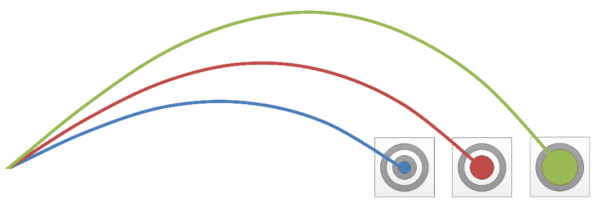External ballistics
Terms

Line of sight
Direct line from your eye, through the scope reticule, to the target.
Line of departure
You might not realize it, but there is an angle between
the line of sight and the barrel. Here the angle is exaggerated
for illustration purposes. Some scope bases increase that angle
to give you extra elevation correction capability with your scope.
Trajectory
Bullet drop is affected by gravity and drag.
Drag is affected by:
- Bullet: ballistic coefficient, muzzle velocity, bullet weight.
- Air density: altitude, barometric pressure, temperature and humidity.
0 (zero)
Is the intersection of the line of sight and the bullet trajectory.
Bullet drop
Difference between a direct line from the rifle muzzle to the target
and the actual trajectory the bullet takes. This is the value indicated
in the ballistics table.
Maximum elevation (or maximum ordinate)
The maximum height the bullet will reach while travelling towards the target.
Trajectory cone
Not all rifles are built equal. Even if all other conditions are perfect - including the shooter - each rifle will shoot inside a certain "trajectory cone". This cone is illustrated below:

In theory, all bullets should hit the same point, but a lot of factors influence bullet path. These variations can be from very little (a great rifle!) to quite severe (a poor rifle!).
Minute of angle (MOA)
Measuring a trajectory cone is done using the MOA. A full circle is divided in 360°. Then 1° is divided in 60 minutes. Hence Minute Of Angle.
So 1 MOA is 1/60th of 1°. 1 MOA roughly equals 1 inch at 100 yards. See the Exact Sizes page for exact values.
Rifle accuracy

If the groups are 1" at 100 yards (the blue target), 2" at 200 yards (the red target) and 3" at 300 yards (the green target), then the rifle producing such groups is said to shoot 1 MOA, which is the minimum acceptable accuracy for a sniper rifle.
The smaller the groups, the more expensive the rifle. Forget about the "perfect" rifle that shoots all bullets in the same hole, it does not exist. But you can get pretty close!
Also note that accuracy is directly related to the ammunition you use. Match ammunition is more precise. Different loads or bullet weight will also affect accuracy.
Physics of ballistics
If you really want to get your brain working, see the excellent page "How do bullets fly?", written by Ruprecht Nennstiel.
Shooting over obstacles
You can attempt to shoot over an obstacle. If you have a good spotter, he can direct your fire towards a target that you cannot see. Ex. set your 0 at 600 yards and shoot a target at 600 yards. At the 400 yards point, your bullet will be much higher than your line of sight. Study the ballistics curves!